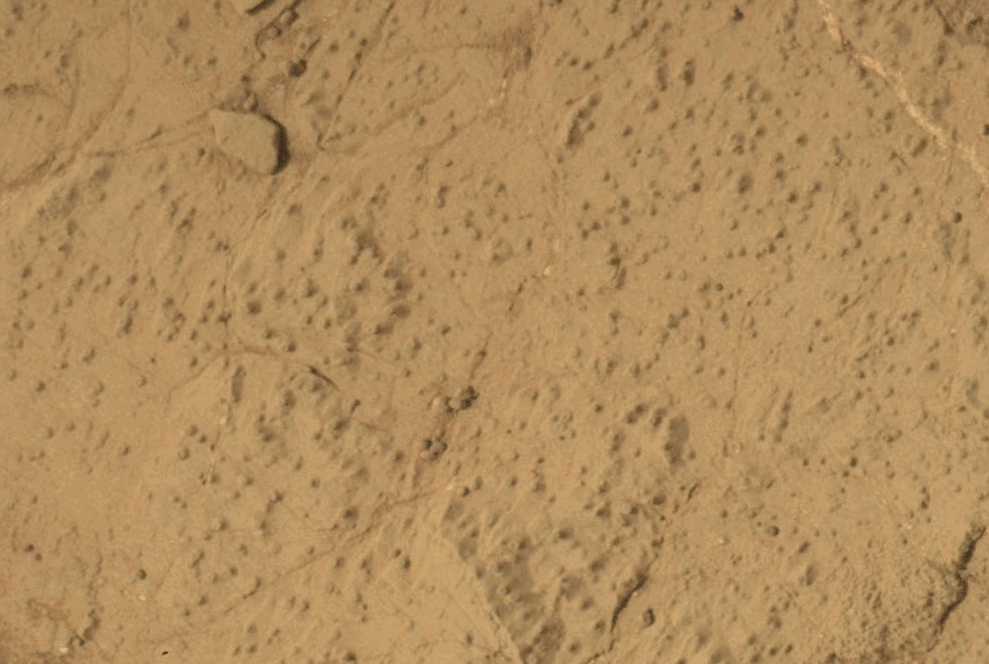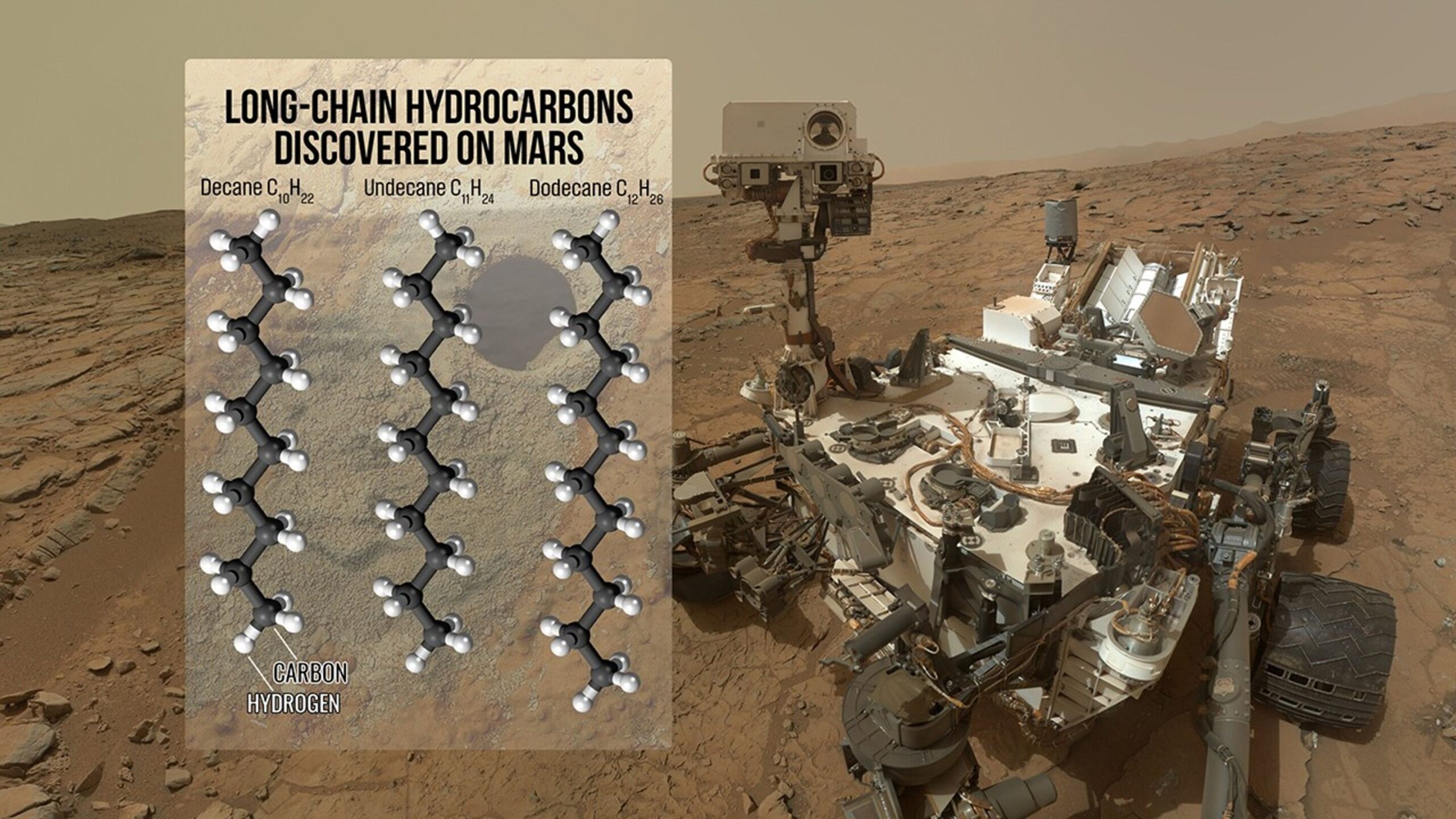For decades, scientists have wondered whether Mars once harbored life. Now, a groundbreaking discovery by NASA’s Curiosity rover is bringing researchers one step closer to answering that question. By analyzing pulverized rock from the ancient Martian surface, scientists have identified the largest organic compounds ever found on the Red Planet. The findings, published in the Proceedings of the National Academy of Sciences, suggest that Mars may have hosted complex prebiotic chemistry—perhaps even edging closer to conditions necessary for life.
This discovery is significant not only because of the molecules identified but also because it demonstrates that organic material can survive on Mars for billions of years. The results pave the way for future missions that could analyze Martian samples more thoroughly—possibly even here on Earth.
What Was Found?
The organic molecules identified—decane, undecane, and dodecane—each consist of long chains of carbon atoms, containing 10, 11, and 12 carbon atoms, respectively. These compounds are believed to be fragments of fatty acids, which are essential biological molecules on Earth.
Fatty acids serve as the building blocks of cell membranes in terrestrial life, but they can also form through non-biological processes. For instance, they may be synthesized through interactions between water and minerals in hydrothermal vents—regions that have been suggested as possible origins for life on Earth.
The discovery marks a new milestone for Mars exploration. Previously, Curiosity had found smaller and simpler organic molecules. However, this is the first time that scientists have uncovered evidence of larger, more complex organic compounds, indicating that Martian organic chemistry may have been more advanced than previously thought.
Why Is This Discovery Important?
1. Supports the Potential for Life on Mars
The presence of fatty acid fragments suggests that Mars had the right chemical conditions to support life. Even though the source of these molecules remains unknown, their existence provides tantalizing clues about the possibility of past biological activity.
“Finding these larger molecules tells us that organic chemistry on Mars advanced beyond just simple compounds,” explained lead study author Caroline Freissinet, a research scientist at the French National Center for Scientific Research. “This increases the chances that Mars once had conditions suitable for life.”
2. Indicates Preservation of Organic Material Over Billions of Years
Another crucial aspect of this discovery is that these organic molecules have survived for an estimated 3.7 billion years—despite Mars’ harsh environment. Scientists have long worried that exposure to intense radiation and oxidation would destroy organic material over time. The fact that these molecules have endured offers hope that even more complex biosignatures, possibly related to past life, may still be preserved on Mars.
“If life ever existed on Mars, its chemical signatures could still be detected today,” said Freissinet. This finding strengthens the case for bringing Martian samples to Earth, where they can be analyzed with the most sophisticated scientific instruments available.
The Origin of the Organics: Biological or Geological?
While the discovery of organic molecules is exciting, their origin remains uncertain. On Earth, fatty acids are primarily biological, but they can also form through non-biological pathways. Similarly, on Mars, these compounds could have formed from purely chemical reactions.
NASA scientists outlined several possible scenarios:
- Biological Origin: If Mars once supported microbial life, these fatty acid fragments could be remnants of ancient cell membranes.
- Geological Origin: The molecules might have been synthesized through interactions between water and minerals, possibly in hydrothermal environments.
- Extraterrestrial Origin: Organic material can also be delivered by meteorites. Some scientists speculate that these compounds may have been brought to Mars from space.
Determining which of these explanations is correct requires further study—preferably with more advanced instruments than those currently on Curiosity.
The Cumberland Sample: A Chemical Treasure Trove
The new study is based on an analysis of a rock sample nicknamed “Cumberland,” which Curiosity drilled from Gale Crater’s Yellowknife Bay region in 2013. Scientists were drawn to this area because it appeared to be an ancient lakebed—a prime location for preserving organic material.

Since then, Cumberland has proven to be an incredibly rich sample, revealing multiple chemical signatures that suggest Mars once had conditions favorable for life. Previous studies of the sample have found:
- Clay minerals formed in water, indicating that Gale Crater once hosted a long-lived lake.
- Sulfur compounds, which can help preserve organic molecules.
- Nitrates, essential nutrients for life on Earth.
- Methane with a specific carbon signature that, on Earth, is often associated with biological activity.
The fact that this one sample contains such a wealth of intriguing chemistry makes it a key piece of the puzzle in understanding Mars’ ancient habitability.
How Scientists Identified the Organic Compounds
The discovery of these fatty acid fragments was actually a byproduct of another experiment. Scientists were originally looking for amino acids, the building blocks of proteins. Using Curiosity’s Sample Analysis at Mars (SAM) instrument, they heated the Cumberland sample in an oven and measured the molecules released.
While no amino acids were detected, researchers instead found small amounts of decane, undecane, and dodecane. Realizing these compounds could be breakdown products of larger organic molecules, they worked backward to determine their original structures. Their analysis suggested that these were fragments of the fatty acids undecanoic acid, dodecanoic acid, and tridecanoic acid.
To confirm their hypothesis, scientists conducted a lab experiment on Earth. They mixed undecanoic acid with a Mars-like clay and subjected it to heating conditions similar to those in the Curiosity rover’s experiment. The result? The fatty acid broke down into the same molecules detected on Mars, confirming their theory.
An Exciting Step Toward Mars Sample Return
While the discovery of organic molecules on Mars is exciting, scientists acknowledge the limitations of Curiosity’s instruments. The rover’s onboard tools, while highly sophisticated, are not capable of definitively determining whether these compounds are of biological origin.
To settle the debate, scientists are looking ahead to the Mars Sample Return (MSR) mission, which aims to bring Martian rock samples back to Earth for detailed analysis. The goal is to use high-precision laboratory equipment to analyze these samples in ways that are impossible with rovers alone.
“We are ready to take the next big step and bring Mars samples home,” said Daniel Glavin, senior scientist for sample return at NASA’s Goddard Space Flight Center. “With access to the most advanced lab instruments on Earth, we may finally answer the question: Did life ever exist on Mars?”
What’s Next for the Search for Life?
NASA’s upcoming Perseverance rover has already begun collecting samples in preparation for a future Mars Sample Return mission. The European Space Agency’s Rosalind Franklin rover, set to launch in the coming years, will further investigate organic compounds on Mars.
In the long term, missions like NASA’s Artemis program, which aims to return humans to the Moon, could pave the way for a crewed mission to Mars. Having human scientists on the Martian surface would allow for more direct and sophisticated exploration.
Conclusion
The discovery of large organic molecules on Mars represents a major leap forward in the search for life beyond Earth. While it does not confirm the existence of past Martian life, it does show that Mars once had the chemical complexity necessary for life to emerge.
With upcoming sample return missions and more advanced rovers on the horizon, scientists are closer than ever to unlocking the secrets of Mars’ past. Whether these newfound molecules were formed by life or by purely chemical processes, they provide yet another compelling reason to continue exploring the Red Planet.
As we push forward in our quest to understand Mars, one thing is clear: the Red Planet is still full of surprises, and its secrets are waiting to be uncovered.
Reference: Caroline Freissinet, Long-chain alkanes preserved in a Martian mudstone, Proceedings of the National Academy of Sciences (2025). DOI: 10.1073/pnas.2420580122. doi.org/10.1073/pnas.2420580122
